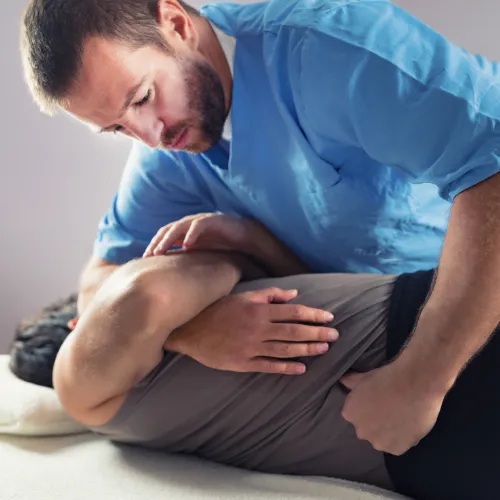Blog > Chiropractic & Stretching
What is Chiropractic & Stretching and Will it Work For Me?
Chiropractic and stretching are both forms of therapy that can be used to alleviate pain, improve mobility, and promote overall health and wellness. Chiropractic involves the manipulation of the spine and other joints to improve alignment and reduce pain, while stretching involves the controlled movement of muscles and joints to improve flexibility and mobility.
Both chiropractic and stretching can be effective for a wide range of conditions, including back pain, neck pain, headaches, and sports injuries. However, the effectiveness of these therapies can vary depending on the individual and their specific condition.
If you’re considering chiropractic and stretching therapy, it’s important to consult with a qualified healthcare provider to determine if these therapies are right for you. They can evaluate your condition and create a personalized treatment plan that may include chiropractic adjustments, and assisted stretching, among other modalities. With the right care and guidance, chiropractic and stretching can be effective tools for improving your health.

The Most Common Techniques for Chiropractic & Stretching
Chiropractic and stretching therapies utilize a variety of techniques to address a wide range of conditions and promote overall health and wellness. Here are some of the most common techniques used in each therapy:

Chiropractic Techniques:
Diversified Technique: This is the most commonly used chiropractic technique, which involves manual manipulation of the spine and other joints to improve alignment and reduce pain.
Gonstead Technique: This technique focuses on specific areas of the spine and uses a variety of tools to improve mobility and alignment.
Thompson Technique: This technique uses a specialized table that drops away when pressure is applied to the spine, allowing for a gentler adjustment.
Activator Technique: This technique uses a small, handheld tool to deliver a precise, low-force adjustment.
Stretching Techniques:
Static Stretching: This involves holding a stretch in one position for an extended period of time to improve flexibility and mobility.
Dynamic Stretching: This involves moving through a series of stretches to improve range of motion and prepare the body for physical activity.
Proprioceptive Neuromuscular Facilitation (PNF): This involves a combination of stretching and contracting muscles to improve range of motion and flexibility.
Assisted Stretching: This involves a trained practitioner using a variety of tools and techniques to help clients achieve a deeper stretch than they can achieve on their own.

Overall, the techniques used in chiropractic and stretching therapies can be customized to meet the individual needs and goals of each patient. With the right care and guidance, these therapies can be effective tools for promoting overall health and wellness.
What is This Form of Chiropractic & Stretching?
The incorporation of chiropractic and stretching is a unique approach to healthcare that combines two distinct modalities to address a wide range of musculoskeletal issues. Chiropractic care involves the manipulation of the spine and joints to improve mobility, reduce pain, and promote healing. Stretching, on the other hand, involves a variety of movements and techniques designed to improve flexibility, range of motion, and muscle function.
What makes this combination of therapies unique is that it addresses both the structural and functional components of musculoskeletal health. Chiropractic care can help to correct misalignments and joint restrictions, which can contribute to pain and dysfunction in the body. Stretching can help to improve flexibility and range of motion, which can reduce the risk of injury and improve overall movement patterns.

Incorporating chiropractic and stretching can also help to address issues that other therapies may not be able to address as effectively. For example, massage therapy can be effective at reducing muscle tension and promoting relaxation, but it may not address underlying joint issues that contribute to pain and dysfunction. Physical therapy may focus on exercise and movement, but may not incorporate the specific adjustments and manipulations of chiropractic care.
Overall, the incorporation of chiropractic and stretching offers a holistic and comprehensive approach to musculoskeletal health that addresses both structural and functional components of the body.
More to Know About Chiropractic & Stretching
Chiropractic care is a non-invasive, drug-free form of healthcare that focuses on the diagnosis, treatment, and prevention of musculoskeletal disorders. It involves the use of hands-on manipulation and adjustment of the spine and other joints in the body to improve mobility, reduce pain, and promote healing. Chiropractors believe that misalignments or restrictions in the spine and joints can interfere with the body's natural healing processes, leading to pain, dysfunction, and other health problems.
Stretching, on the other hand, involves a variety of movements and techniques designed to improve flexibility, range of motion, and muscle function. Regular stretching can help to reduce muscle tension and promote relaxation, as well as improve joint mobility and decrease the risk of injury. Stretching can also help to improve circulation, which can promote healing and reduce pain.

When used together, chiropractic care and stretching can be a powerful combination for people with chronic pain. Chronic pain is often associated with musculoskeletal problems, such as back pain, neck pain, and joint pain. Chiropractic care can help to address the underlying structural issues that contribute to this pain, such as misalignments or joint restrictions. Stretching can help to improve flexibility and range of motion, reducing the strain on the muscles and joints and reducing pain.
In addition to addressing the physical components of chronic pain, chiropractic care and stretching can also help to improve overall health and wellness. Regular chiropractic care can help to improve immune function, reduce stress, and improve sleep quality. Stretching can also help to reduce stress and promote relaxation, as well as improve circulation and cardiovascular health.
Overall, the combination of chiropractic care and stretching can be an effective treatment option for people with chronic pain. By addressing both the structural and functional components of musculoskeletal health, chiropractic care and stretching can help to reduce pain, improve mobility, and promote overall health and wellness.
Contact Us
Hours
Social Media
Monday - Friday: 10:00 AM - 7:00 PM
Saturday: By appointment only
Sunday: Closed
Blog > What is Chiropractic & Stretching?
What is Chiropractic & Stretching and Will it Work For Me?

Chiropractic and stretching are both forms of therapy that can be used to alleviate pain, improve mobility, and promote overall health and wellness. Chiropractic involves the manipulation of the spine and other joints to improve alignment and reduce pain, while stretching involves the controlled movement of muscles and joints to improve flexibility and mobility.
Both chiropractic and stretching can be effective for a wide range of conditions, including back pain, neck pain, headaches, and sports injuries. However, the effectiveness of these therapies can vary depending on the individual and their specific condition.
If you’re considering chiropractic and stretching therapy, it’s important to consult with a qualified healthcare provider to determine if these therapies are right for you. They can evaluate your condition and create a personalized treatment plan that may include chiropractic adjustments, and assisted stretching, among other modalities. With the right care and guidance, chiropractic and stretching can be effective tools for improving your health.
The Most Common Techniques for Chiropractic & Stretching
Chiropractic and stretching therapies utilize a variety of techniques to address a wide range of conditions and promote overall health and wellness. Here are some of the most common techniques used in each therapy:

Chiropractic Techniques:
Diversified Technique:
This is the most commonly used chiropractic technique, which involves manual manipulation of the spine and other joints to improve alignment and reduce pain.
Gonstead Technique: This technique focuses on specific areas of the spine and uses a variety of tools to improve mobility and alignment.
Thompson Technique: This technique uses a specialized table that drops away when pressure is applied to the spine, allowing for a gentler adjustment.
Activator Technique: This technique uses a small, handheld tool to deliver a precise, low-force adjustment.

Stretching Techniques:
Static Stretching: This involves holding a stretch in one position for an extended period of time to improve flexibility and mobility.
Dynamic Stretching: This involves moving through a series of stretches to improve range of motion and prepare the body for physical activity.
Proprioceptive Neuromuscular Facilitation (PNF): This involves a combination of stretching and contracting muscles to improve range of motion and flexibility.
Assisted Stretching: This involves a trained practitioner using a variety of tools and techniques to help clients achieve a deeper stretch than they can achieve on their own.
Overall, the techniques used in chiropractic and stretching therapies can be customized to meet the individual needs and goals of each patient. With the right care and guidance, these therapies can be effective tools for promoting overall health and wellness.
What is This Type of Chiropractic & Stretching?
The incorporation of chiropractic and stretching is a unique approach to healthcare that combines two distinct modalities to address a wide range of musculoskeletal issues. Chiropractic care involves the manipulation of the spine and joints to improve mobility, reduce pain, and promote healing. Stretching, on the other hand, involves a variety of movements and techniques designed to improve flexibility, range of motion, and muscle function.
What makes this combination of therapies unique is that it addresses both the structural and functional components of musculoskeletal health. Chiropractic care can help to correct misalignments and joint restrictions, which can contribute to pain and dysfunction in the body. Stretching can help to improve flexibility and range of motion, which can reduce the risk of injury and improve overall movement patterns.

Incorporating chiropractic and stretching can also help to address issues that other therapies may not be able to address as effectively. For example, massage therapy can be effective at reducing muscle tension and promoting relaxation, but it may not address underlying joint issues that contribute to pain and dysfunction. Physical therapy may focus on exercise and movement, but may not incorporate the specific adjustments and manipulations of chiropractic care.
Overall, the incorporation of chiropractic and stretching offers a holistic and comprehensive approach to musculoskeletal health that addresses both structural and functional components of the body.
More to Know About Chiropractic & Stretching
Chiropractic care is a non-invasive, drug-free form of healthcare that focuses on the diagnosis, treatment, and prevention of musculoskeletal disorders. It involves the use of hands-on manipulation and adjustment of the spine and other joints in the body to improve mobility, reduce pain, and promote healing. Chiropractors believe that misalignments or restrictions in the spine and joints can interfere with the body's natural healing processes, leading to pain, dysfunction, and other health problems.
Stretching, on the other hand, involves a variety of movements and techniques designed to improve flexibility, range of motion, and muscle function. Regular stretching can help to reduce muscle tension and promote relaxation, as well as improve joint mobility and decrease the risk of injury. Stretching can also help to improve circulation, which can promote healing and reduce pain.

When used together, chiropractic care and stretching can be a powerful combination for people with chronic pain. Chronic pain is often associated with musculoskeletal problems, such as back pain, neck pain, and joint pain. Chiropractic care can help to address the underlying structural issues that contribute to this pain, such as misalignments or joint restrictions. Stretching can help to improve flexibility and range of motion, reducing the strain on the muscles and joints and reducing pain.
In addition to addressing the physical components of chronic pain, chiropractic care and stretching can also help to improve overall health and wellness. Regular chiropractic care can help to improve immune function, reduce stress, and improve sleep quality. Stretching can also help to reduce stress and promote relaxation, as well as improve circulation and cardiovascular health.
In conclusion, the combination of chiropractic care and stretching can be an effective treatment option for people with chronic pain. By addressing both the structural and functional components of musculoskeletal health, chiropractic care and stretching can help to reduce pain, improve mobility, and promote overall health and wellness.
Contact Us
(239) 977-5353
Hours
Monday - Friday: 10:00 AM - 7:00 PM
Saturday: By appointment only
Sunday: Closed
Social Media







